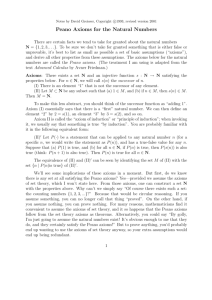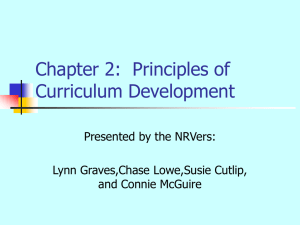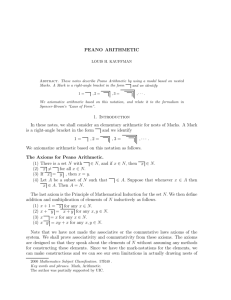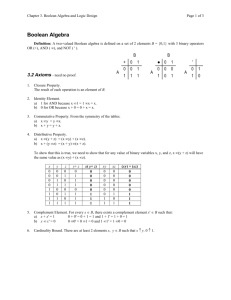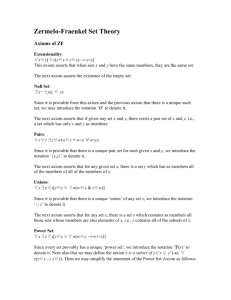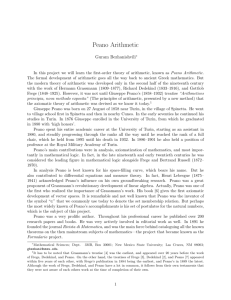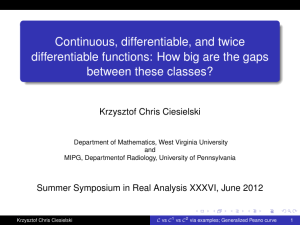Axiom`s of the Natural Numbers – Peano
advertisement
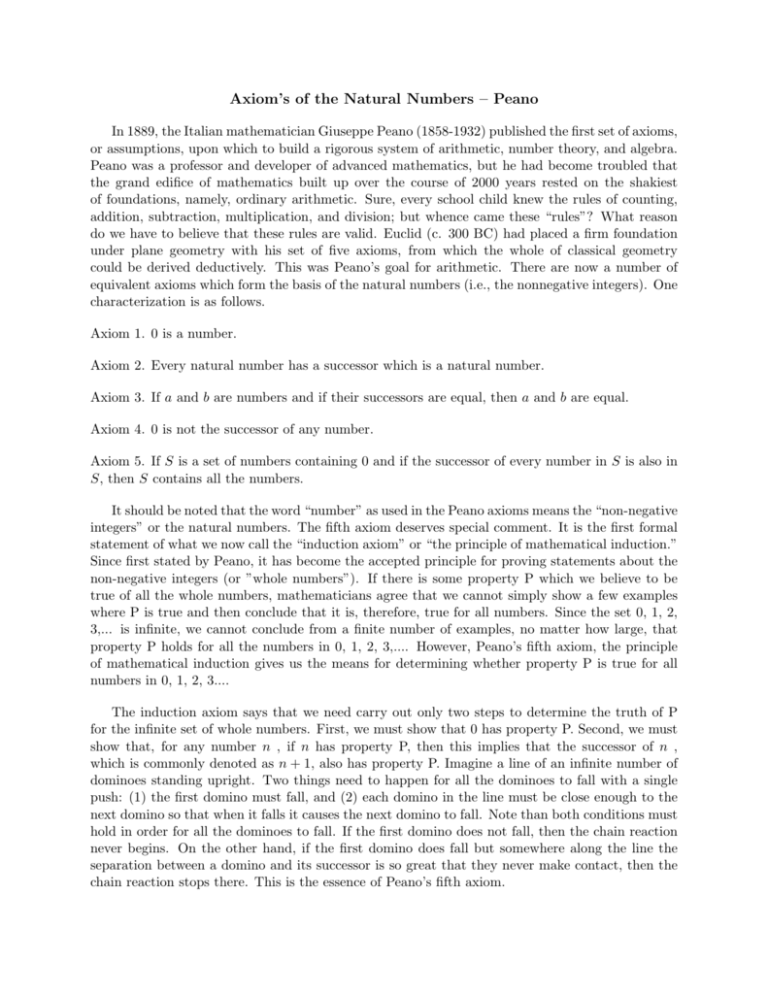
Axiom’s of the Natural Numbers – Peano In 1889, the Italian mathematician Giuseppe Peano (1858-1932) published the first set of axioms, or assumptions, upon which to build a rigorous system of arithmetic, number theory, and algebra. Peano was a professor and developer of advanced mathematics, but he had become troubled that the grand edifice of mathematics built up over the course of 2000 years rested on the shakiest of foundations, namely, ordinary arithmetic. Sure, every school child knew the rules of counting, addition, subtraction, multiplication, and division; but whence came these “rules”? What reason do we have to believe that these rules are valid. Euclid (c. 300 BC) had placed a firm foundation under plane geometry with his set of five axioms, from which the whole of classical geometry could be derived deductively. This was Peano’s goal for arithmetic. There are now a number of equivalent axioms which form the basis of the natural numbers (i.e., the nonnegative integers). One characterization is as follows. Axiom 1. 0 is a number. Axiom 2. Every natural number has a successor which is a natural number. Axiom 3. If a and b are numbers and if their successors are equal, then a and b are equal. Axiom 4. 0 is not the successor of any number. Axiom 5. If S is a set of numbers containing 0 and if the successor of every number in S is also in S, then S contains all the numbers. It should be noted that the word “number” as used in the Peano axioms means the “non-negative integers” or the natural numbers. The fifth axiom deserves special comment. It is the first formal statement of what we now call the “induction axiom” or “the principle of mathematical induction.” Since first stated by Peano, it has become the accepted principle for proving statements about the non-negative integers (or ”whole numbers”). If there is some property P which we believe to be true of all the whole numbers, mathematicians agree that we cannot simply show a few examples where P is true and then conclude that it is, therefore, true for all numbers. Since the set 0, 1, 2, 3,... is infinite, we cannot conclude from a finite number of examples, no matter how large, that property P holds for all the numbers in 0, 1, 2, 3,.... However, Peano’s fifth axiom, the principle of mathematical induction gives us the means for determining whether property P is true for all numbers in 0, 1, 2, 3.... The induction axiom says that we need carry out only two steps to determine the truth of P for the infinite set of whole numbers. First, we must show that 0 has property P. Second, we must show that, for any number n , if n has property P, then this implies that the successor of n , which is commonly denoted as n + 1, also has property P. Imagine a line of an infinite number of dominoes standing upright. Two things need to happen for all the dominoes to fall with a single push: (1) the first domino must fall, and (2) each domino in the line must be close enough to the next domino so that when it falls it causes the next domino to fall. Note than both conditions must hold in order for all the dominoes to fall. If the first domino does not fall, then the chain reaction never begins. On the other hand, if the first domino does fall but somewhere along the line the separation between a domino and its successor is so great that they never make contact, then the chain reaction stops there. This is the essence of Peano’s fifth axiom. One of the great beauties of the Peano axioms is that they make possible the generation of an infinite set of numbers from a finite number of symbols. Essentially, Peano hands us two items, the number 0 and the concept “successor”, and an “instruction manual,” i.e, his five axioms, and promises us that with just these we can build an entire system of arithmetic. As a first step in building this arithmetic system, we may generate all the natural numbers(positive integers) as follows. Let us agree that if n is any number, rather than writing out “the successor of n ,” we will write “s(n).” Peano has given us 0. Axiom 1 says that 0 is a number and Axiom 2 says that the successor of any number is a number. Therefore, s(0) is a number, s(s(0)) is a number, s(s(s(0))) is a number, and so on. Clearly this process, if continued forever, is sufficient to generate all the natural numbers. As each new natural number is “born” by our process, we may want to give it a name. For instance we may wish to call s(0) “Sam” or “Samantha” or, preferably, “1.” To our newly generated s(s(0)), which clearly is s(1), we will give the name “2.” We shall call s(s(s(0))) = s(s(1)) = s(2) by the name “3” and so forth. Thus the set 1, 2, 3,... is generated. Having generated the natural numbers, we can next begin to define operations on those numbers. For example, Peano defines addition as follows: For any natural numbers n and k : i. n + 0 = n and ii. n + s(k) = s(n + k). So the addition “2 + 1” is interpreted as 2 + 1 = 2 + s(0) = s(2+0) = s(2) = 3. Multiplication can be defined in a similar way. Source: http://www.bookrags.com/research/peano-axioms-wom/ 2

